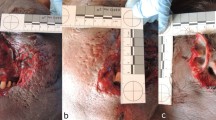Abstract
Analyses of the hypnotic triazolam from the remains of two human skeletons buried underground for 4 years were made for purposes of confirmation. The bone marrow and mummified muscle were digested with 2 M sodium hydroxide, efficiently extracted using a 3-step solvent extraction procedure, and selectively analyzed by gas chromatography/mass spectrometry with the negative ion chemical ionization mode. Estazolam was the internal standard used. Triazolam was detected in all the samples; the concentrations were 0.36 ng/g in the bone marrow of one victim, and 0.37 and 5.5 ng/g in the bone marrow and mummified muscle of the other victim. This method should prove useful for determination of triazolam in extensively decomposed bodies.
Similar content being viewed by others
Author information
Authors and Affiliations
Additional information
Received: 11 February 1997 / Received in revised form: 14 April 1997
Rights and permissions
About this article
Cite this article
Kudo, K., Sugie, H., Syoui, N. et al. Detection of triazolam in skeletal remains buried for 4 years. Int J Leg Med 110, 281–283 (1997). https://doi.org/10.1007/s004140050086
Issue Date:
DOI: https://doi.org/10.1007/s004140050086




